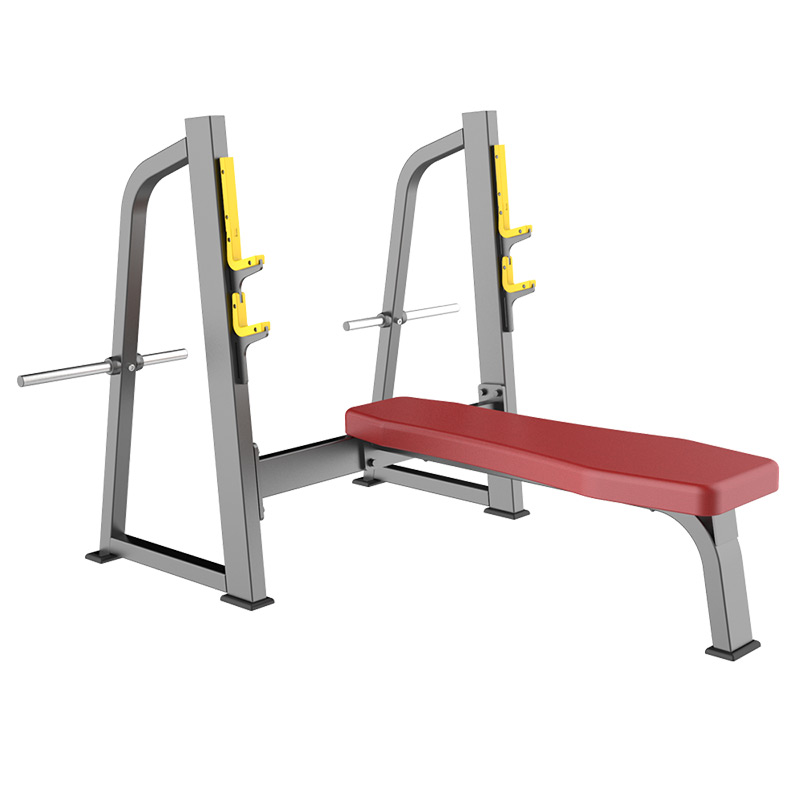The Olympic Bench is a cornerstone piece of gym equipment designed for performing a variety of strength training exercises, particularly focused on upper body development. It’s a versatile platform that accommodates Olympic-sized barbells and weight plates, making it suitable for users at different fitness levels. Here’s an introduction to its features, benefits, and typical uses:
Features of the Olympic Bench
- Heavy-Duty Construction: Built with a sturdy frame typically made from steel or heavy-duty materials to support heavy weights and ensure stability during exercises.
- Wide and Padded Platform: Features a wide and padded platform to provide stability and comfort for users during exercises like bench presses.
- Adjustable Settings: Includes adjustable settings for the backrest and sometimes the seat, allowing users to perform exercises at various angles such as flat, incline, and decline.
- Rack Compatibility: Often equipped with racks or hooks to hold an Olympic-sized barbell securely in place, facilitating safe and efficient loading and unloading of weights.
- Spotter Platform: Some models include a spotter platform at the back to ensure safety during heavy lifts by providing a stable platform for spotters to assist.
Benefits of Using the Olympic Bench
- Comprehensive Upper Body Workout: Supports a wide range of upper body exercises, including bench presses (flat, incline, decline), shoulder presses, and arm exercises, promoting overall upper body strength and muscle development.
- Strength and Muscle Definition: Enables users to build strength and enhance muscle definition in the chest, shoulders, triceps, and other upper body muscles through progressive resistance training.
- Versatility: Allows for versatility in training routines by adjusting the bench angle for targeting different muscle groups and accommodating various exercise preferences.
- Progressive Overload: Facilitates progressive overload by adjusting the weight plates on the barbell, enabling users to increase resistance gradually as strength improves.
- Safety and Stability: Provides a stable platform for lifting heavy weights safely, with features like rack compatibility and spotter platforms ensuring proper form and reducing the risk of injury.
Typical Uses
- Flat Bench Press: The fundamental exercise performed on the Olympic Bench, involving lowering and lifting a barbell or dumbbells while lying flat on the bench to target the chest muscles.
- Incline Bench Press: Adjusting the bench to an incline angle targets the upper chest and shoulders more intensely, enhancing upper chest development.
- Decline Bench Press: Setting the bench to a decline angle focuses on the lower chest muscles and provides a different angle of resistance for comprehensive chest development.
- Shoulder Press: Performing seated or standing shoulder presses to target the deltoid muscles (shoulders) and triceps.
- Arm Exercises: Utilizing the bench for exercises like bicep curls, tricep extensions, and other arm exercises to isolate and strengthen arm muscles.
Proper Usage
- Setup: Adjust the bench to the desired position (flat, incline, decline) using the adjustment mechanism. Ensure the bench is stable and securely positioned on a flat surface.
- Starting Position: Position yourself on the bench according to the exercise you intend to perform, ensuring proper alignment of your body and limbs.
- Execution: Perform the exercise with controlled movements, focusing on proper form, full range of motion, and engaging the targeted muscles throughout.
- Breathing: Inhale before lowering the weight (eccentric phase) and exhale during the effort (concentric phase) of each repetition.
- Repetitions: Complete the desired number of repetitions and sets based on your training goals and fitness level.
Tips for Effective Use
- Warm-Up: Warm up your muscles with light cardio or dynamic stretches before using the bench to prepare your body for exercise.
- Proper Form: Maintain correct posture and alignment throughout the exercise to prevent injury and maximize muscle engagement.
- Controlled Movements: Perform exercises with controlled and deliberate motions, avoiding rapid or jerky movements.
- Weight Selection: Choose an appropriate weight that allows you to complete your repetitions with good form. Gradually increase the weight as your strength improves.
- Safety Considerations: Ensure the bench is stable and adjustments are securely locked before starting exercises. Use spotters for heavy lifts like bench presses for added safety.




















































Reviews
There are no reviews yet.